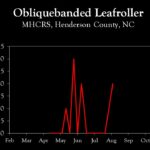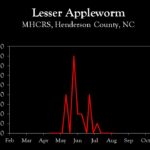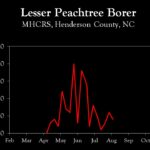WNC Orchard Insect Pest Populations – August 7, 2024
go.ncsu.edu/readext?1018312
en Español / em Português
El inglés es el idioma de control de esta página. En la medida en que haya algún conflicto entre la traducción al inglés y la traducción, el inglés prevalece.
Al hacer clic en el enlace de traducción se activa un servicio de traducción gratuito para convertir la página al español. Al igual que con cualquier traducción por Internet, la conversión no es sensible al contexto y puede que no traduzca el texto en su significado original. NC State Extension no garantiza la exactitud del texto traducido. Por favor, tenga en cuenta que algunas aplicaciones y/o servicios pueden no funcionar como se espera cuando se traducen.
Português
Inglês é o idioma de controle desta página. Na medida que haja algum conflito entre o texto original em Inglês e a tradução, o Inglês prevalece.
Ao clicar no link de tradução, um serviço gratuito de tradução será ativado para converter a página para o Português. Como em qualquer tradução pela internet, a conversão não é sensivel ao contexto e pode não ocorrer a tradução para o significado orginal. O serviço de Extensão da Carolina do Norte (NC State Extension) não garante a exatidão do texto traduzido. Por favor, observe que algumas funções ou serviços podem não funcionar como esperado após a tradução.
English
English is the controlling language of this page. To the extent there is any conflict between the English text and the translation, English controls.
Clicking on the translation link activates a free translation service to convert the page to Spanish. As with any Internet translation, the conversion is not context-sensitive and may not translate the text to its original meaning. NC State Extension does not guarantee the accuracy of the translated text. Please note that some applications and/or services may not function as expected when translated.
Collapse ▲ First generation brown marmorated stink bug continues to emerge throughout the region. Temperatures have not been quite as warm as predicted last week, so emergence has slowed slightly, but according to the model it ranges from about 16% complete at 2000 ft elevation (806 degree days (DD)) to 62% at 1,000 ft (1032 DD). The uptick in pheromone trap captures has only slightly increased in the past week, but we are definitely seeing adult BMSB with greater frequency in the field. Control over the next few weeks will likely be important on the most susceptible cultivars.
First generation brown marmorated stink bug continues to emerge throughout the region. Temperatures have not been quite as warm as predicted last week, so emergence has slowed slightly, but according to the model it ranges from about 16% complete at 2000 ft elevation (806 degree days (DD)) to 62% at 1,000 ft (1032 DD). The uptick in pheromone trap captures has only slightly increased in the past week, but we are definitely seeing adult BMSB with greater frequency in the field. Control over the next few weeks will likely be important on the most susceptible cultivars.
Throughout the region, second generation codling moth flight is complete, and third generation populations are historically not a problem unless there were issues with second generation damage. In other words, it is highly unlikely that problems will arise from here on in the absence of damage at this point.
Finally, reports from Avery County indicate that apple maggot captures on traps increased above threshold levels last week. Apple maggot populations are typically more intense in higher elevation locations, so control options should be considered in those areas. Numbers also increased to about 2 per trap near an abandoned orchard in Henderson County this week.
Learn more about southeastern apple insect pests at the Apple Insect Management page.
2024 Average Weekly Trap Captures
| HENDERSON COUNTY | |||
| Insects per trap | |||
| Jul 22 | Jul 29 | Aug 5 | |
| Codling moth | 2.5 | 1.5 | 0.5 |
| Oriental fruit moth | 14.0 | 11.0 | 11.0 |
| Tufted apple bud moth | 3.0 | 0.0 | 0.0 |
| Redbanded leafroller | 0.0 | 0.0 | 0.0 |
| Obliquebanded leafroller | 0.0 | 1.0 | 2.0 |
| Lesser appleworm | 0.0 | 0.0 | 0.0 |
| Apple maggot (research orchards) | 0.0 | 0.0 | 0.0 |
| Apple maggot (abandoned orchard) | 0.0 | 0.0 | 2.0 |
| Brown marmorated stink bug (commercial) | 0.3 | 1.0 | 1.3 |
| Brown marmorated stink bug (unsprayed research orchard) | 0.0 | 0.7 | 0.3 |
| Spotted tentiform leafminer | 0.0 | 0.0 | 0.0 |
| Dogwood borer | 33.0 | 28.0 | 18.0 |
| Peachtree borer | 20.0 | 2.0 | 14.0 |
| Lesser peachtree borer | 3.0 | 6.0 | 4.0 |
| San Jose scale | 5.0 | 2.5 | 5.0 |
*Note that these averages illustrate only the timing of insect emergence and fluctuations in populations, and are not representative of population levels in any given orchard. The only way to have an accurate assessment of an individual orchard’s populations is to set up traps in that orchard.
2024 Accumulated Degree Days
| HENDERSON COUNTY | ||||
| Jul 22 | Jul 29 | Aug 5 | ||
| Codling moth (Biofix: April 15) | 1834 | 2026 | 2184 | |
| Oriental fruit moth (Biofix: March 15) | 2597 | 2829 | 3017 | |
| Tufted apple bud moth (Biofix: April 15) | 2303 | 2535 | 2723 | |















